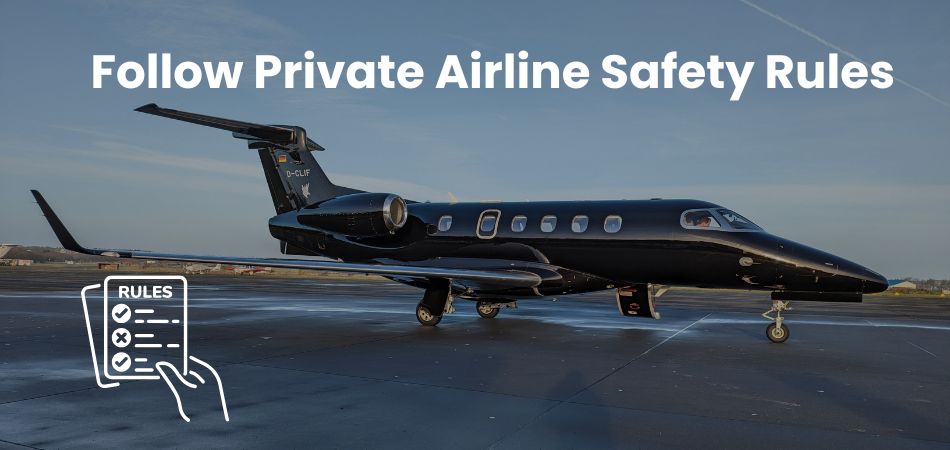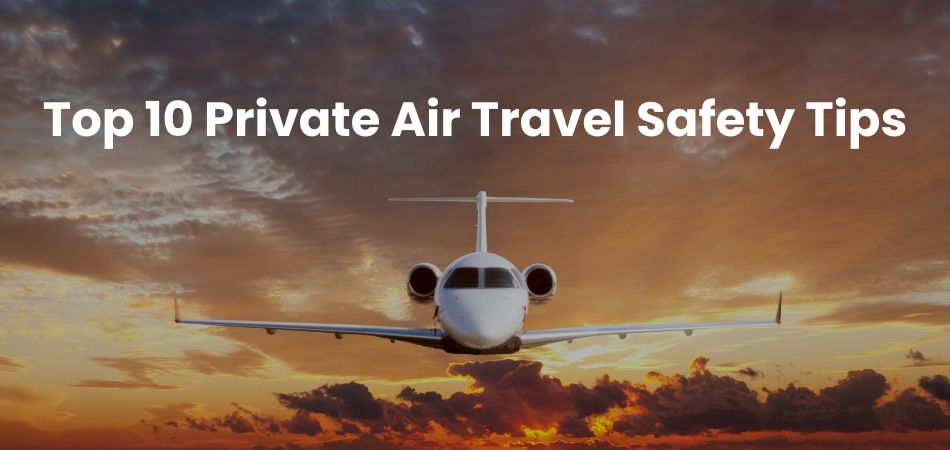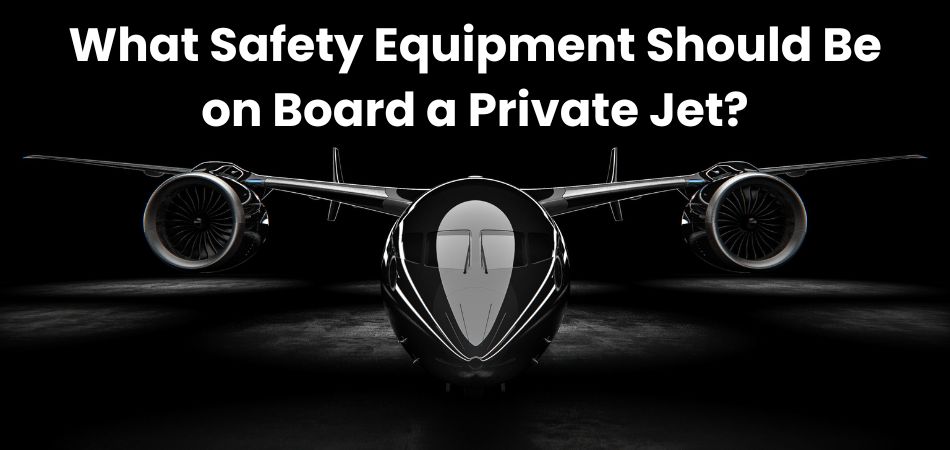Private air travel offers superior convenience, privacy, and flexibility, making it a preferred choice for many. However, ensuring safety is just as crucial in private aviation as commercial flights. To help you travel the skies confidently, we’ve compiled the top 10 private air travel safety tips you need to know.
You should choose a reputable company, verify pilot credentials, check maintenance records, attend safety briefings, and stay prepared. Always confirm weather conditions, ensure proper weight distribution, and verify the availability of emergency equipment onboard.
Throughout this blog, we’ll walk you through the most important private air travel safety tips, so you can travel confidently and securely. Do you want peace of mind when you travel? Keep reading to discover how these tips can help you stay secure and make the most of your next private flight.
Is It Important to Follow Private Airline Safety Rules?
Private air travel offers superior convenience and comfort, but safety should always remain a top priority. Adhering to safety rules ensures a smooth, risk-free experience for passengers and crew. Below are some key areas explaining why following private airline safety rules is absolutely essential.

Safety Rules Minimize Risks During Flight
Safety protocols are designed to address and mitigate common flight risks, from turbulence to mechanical issues. By following these rules, passengers and crew can remain prepared for unexpected situations. Ignoring these guidelines could compromise the safety of everyone onboard.
Compliance Ensures the Aircraft Is Airworthy
Private airlines follow strict safety inspections to confirm the aircraft is fit for flying. Passengers should ensure these checks are conducted and documented before every flight. Compliance with these rules prevents issues like equipment failure or mid-air emergencies.
Proper Safety Briefings Protect Passengers
Safety briefings might seem repetitive but provide invaluable information on using onboard safety equipment. These briefings explain procedures for emergencies, such as using oxygen masks or locating exits. Following this guidance increases your chances of staying safe during unexpected events.
Crew Training and Rules Maintain Safety Standards
Private airlines enforce safety rules to ensure their crew is highly trained and capable. These rules require pilots and attendants to adhere to specific operational guidelines. Following safety protocols improves decision-making and passenger well-being throughout the flight.
Rules Support Crisis Management and Preparedness
Emergencies, while rare, can occur without warning, making preparedness essential. Safety rules mandate protocols for handling medical, weather-related, or technical emergencies. Respecting these rules helps ensure swift and organized crisis management, reducing potential harm.
Top 10 Private Air Travel Safety Tips You Need to Know
Private air travel combines luxury, convenience, and efficiency, but safety should always be your top priority. Whether you are a first-time flyer or a frequent private traveler, understanding key safety practices is essential for a smooth and secure experience. Here are the top 10 private air travel safety tips you need to know to ensure every journey is as safe as it is comfortable.

1. Choose a Reputable Charter Company
The safety of your flight begins with the charter company you select. Always research the company’s safety record, certifications, and reputation before booking. Look for accreditations from organizations like ARGUS or Wyvern, which audit safety standards. A reputable company will prioritize safety over everything else, giving you peace of mind.
2. Verify the Pilot’s Experience and Credentials
Your safety relies heavily on the pilot’s skill and experience. Always inquire about the pilot’s certifications, total flight hours, and experience flying the specific aircraft model. Well-trained pilots are better equipped to handle unexpected situations. Trusting an experienced crew ensures a safer and smoother flight.
3. Inspect the Aircraft’s Maintenance Records
Before flying, confirm that the aircraft is regularly maintained and inspected. Maintenance logs provide evidence that the jet has passed all necessary safety checks. Proper upkeep prevents mechanical failures and ensures the plane is airworthy. Never hesitate to ask for documentation to verify the aircraft’s condition.
4. Always Attend the Safety Briefing
No matter how often you fly, attending the pre-flight safety briefing is essential. These briefings familiarize you with onboard safety equipment, emergency exits, and protocols. Knowing how to use oxygen masks or life vests can make all the difference in an emergency. Pay attention to instructions for a safer journey.
5. Check Weather Conditions Before Your Flight
Weather plays a crucial role in the safety of any flight, private or commercial. Ask your crew or charter service for updates on weather conditions, especially when flying to remote areas. If conditions seem unfavorable, delays or rescheduling may be the safest option. Always prioritize safety over sticking to a rigid schedule.
6. Ensure Proper Weight and Balance of the Aircraft
Overloading or improper weight distribution can impact the aircraft’s performance. Crews follow strict guidelines to balance passenger weight, luggage, and fuel. Make sure you communicate accurate baggage details and avoid last-minute changes. Proper weight management enhances safety during takeoff, flight, and landing.
7. Confirm the Availability of Emergency Equipment
Safety equipment like first aid kits, fire extinguishers, life vests, and oxygen masks should be onboard and easily accessible. Before takeoff, confirm that all equipment is functional and available. Knowing the location of these tools prepares you for any unexpected situations. Always prioritize a safety-ready aircraft.
8. Follow All Safety Instructions and Guidelines
Crew members provide instructions for your safety, so it’s crucial to follow their guidelines. Whether it’s fastening seat belts, securing luggage, or remaining seated, these rules are in place for a reason. Ignoring them could compromise your safety in turbulent conditions. Respect the crew’s expertise and comply with their directions.
9. Stay Informed About Emergency Procedures
Knowing what to do during an emergency is vital. Take note of exits, emergency lights, and instructions for evacuation. Ask questions during the briefing if you are unsure about any procedure. Being proactive ensures you can respond calmly and effectively if an incident arises.
10. Plan for Unexpected Situations
Even in private air travel, unexpected events like delays, diversions, or medical emergencies can occur. Carry essential medications, extra communication devices, and necessary travel documents. Discuss contingency plans with the crew and ensure you’re prepared for all possibilities. Staying prepared keeps minor disruptions from turning into bigger problems.
What Do You Wear on a Private Jet?
When flying on a private jet, comfort and style are key. Unlike commercial flights, private air travel often blends business and leisure, so your outfit should be versatile and polished. For men, perfectly fitted chinos or dress pants paired with a smart shirt or blazer offer a classic look. Women can opt for elegant, comfortable attire like a maxi dress, stylish separates, or well-fitted trousers with a blouse.
Consider the purpose of your trip and dress accordingly. If traveling for business, stick to professional attire to maintain a polished impression. For casual getaways, prioritize comfort without sacrificing style—think luxury fabrics like cashmere sweaters, soft leather loafers, or chic travel sets. Avoid overly casual items like flip-flops, gym wear, or ripped jeans.
So, you should choose footwear that’s practical yet refined, as you may need to move through airports or unfamiliar terrain. Layers, such as light jackets or wraps, are also helpful for changing cabin temperatures.
What Safety Equipment Should Be on Board a Private Jet?
Private jets are designed for comfort and efficiency, but safety remains the top priority for any flight. Having the right safety equipment onboard ensures passengers and crew are prepared for unexpected situations. Below are some essential pieces of safety equipment that should always be present on a private jet.

- First Aid Kits: A well-stocked first aid kit is essential for addressing minor injuries or medical emergencies during the flight. It should include basic supplies like bandages, antiseptics, and medications to handle common in-flight health concerns.
- Oxygen Masks: In the event of a sudden drop in cabin pressure, oxygen masks are mandatory for passenger safety. Masks should deploy automatically and be easy to locate to provide sufficient oxygen until normal cabin pressure is restored.
- Life Vests and Rafts: For flights that cross bodies of water, life vests and inflatable rafts are mandatory. These devices ensure passenger safety during water landings and should be accessible under or near seats.
- Fire Extinguishers: Onboard fire extinguishers are crucial for handling small fires before they escalate. The crew should be trained in using them effectively, and they must be placed in easily accessible locations.
- Emergency Locator Transmitters (ELTs): ELTs help rescue teams locate the aircraft in case of an emergency landing or crash. These devices send out signals to search and rescue operations, improving the chances of a timely response.
Do You Need to Check the Pilot’s Credentials?
Yes, checking the pilot’s credentials is important when flying on a private jet. A pilot’s experience, training, and certifications directly impact your flight’s safety and quality. Reputable charter companies will gladly provide details about their pilots, including licenses, flight hours, and the specific training they’ve undergone for the aircraft you’ll be flying.
A qualified pilot should hold a valid FAA-issued license or an equivalent certification depending on the region. It’s also crucial to confirm their experience with private jet operations and the specific aircraft model you’re boarding. Pilots who meet high safety standards undergo regular proficiency checks, ensuring they’re prepared for various flight scenarios and emergencies.
By verifying credentials, you gain confidence that your flight crew is professional and capable. Never hesitate to ask for these details—your safety depends on cockpit expertise. Trusting a qualified pilot ensures a smooth and secure private air travel experience.
FAQs About Private Air Travel Safety
Private air travel is known for its luxury and convenience, but many travelers still have questions about safety and operations. From security checks to onboard protocols, understanding these aspects can make your private jet experience more secure and enjoyable. Here are some frequently asked questions (FAQs) with clear answers to help you feel more confident when flying privately.
1. Are Private Jets Subject to Security Checks?
Yes, private jets follow strict security regulations, but the process is streamlined compared to commercial flights. Passengers and luggage are screened for safety, though the procedures are faster and more discreet. Security is often handled at private terminals or FBOs (Fixed Base Operators) to ensure efficiency and privacy.
2. Can I Bring My Own Food and Drinks on a Private Jet?
Yes, you can typically bring your preferred food and beverages onboard a private jet. Many charter services also provide customized catering based on your preferences. However, it’s a good idea to confirm any restrictions, especially for international flights.
3. Are Pets Allowed on Private Jets?
Most private jets allow pets to accompany passengers, making them an excellent choice for pet owners. Pets can often travel in the cabin rather than the cargo hold, ensuring their comfort. Always inform the charter company in advance so they can make proper arrangements.
4. What Should I Do in Case of an Emergency During the Flight?
In case of an emergency, remain calm and follow the instructions provided by the flight crew. Private jets are equipped with safety equipment like oxygen masks, life vests, and emergency locator transmitters. Attending the pre-flight safety briefing will ensure you’re familiar with these procedures.
5. How Can I Ensure My Privacy During Private Air Travel?
Private jet travel is designed to provide maximum privacy for passengers. Booking through a reputable charter company ensures confidentiality, as they often sign non-disclosure agreements. Additionally, private terminals reduce exposure to crowds and public scrutiny.
Final Thoughts
Private air travel offers superior comfort, flexibility, and privacy, but safety should always remain a top priority. By following the top 10 private air travel safety tips you need to know, you can ensure a smooth and secure flying experience.
From verifying the pilot’s credentials to understanding onboard safety equipment, these tips empower you to make informed decisions for every flight.
Safety is the foundation of a truly enjoyable private jet journey, allowing you to focus on the perks of traveling in style. Prioritize these guidelines, and you’ll always fly with confidence, peace of mind, and security. Safe travels!
